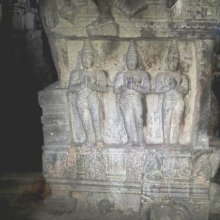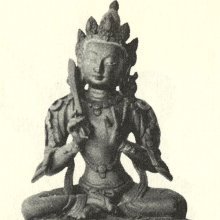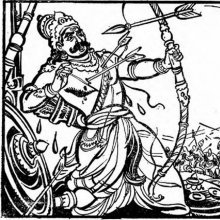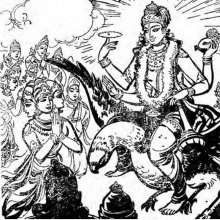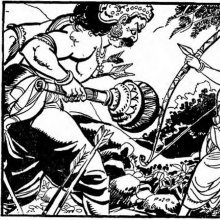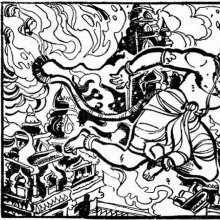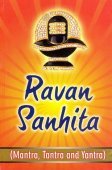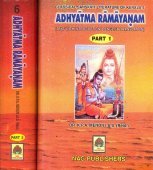Rakshasa, Rākṣasa, Rakṣasa: 41 definitions
Introduction:
Rakshasa means something in Buddhism, Pali, Hinduism, Sanskrit, Jainism, Prakrit, the history of ancient India, Marathi, Hindi. If you want to know the exact meaning, history, etymology or English translation of this term then check out the descriptions on this page. Add your comment or reference to a book if you want to contribute to this summary article.
The Sanskrit terms Rākṣasa and Rakṣasa can be transliterated into English as Raksasa or Rakshasa, using the IAST transliteration scheme (?).
Images (photo gallery)
(+18 more images available)
In Hinduism
Natyashastra (theatrics and dramaturgy)
Source: Wisdom Library: Nāṭya-śāstra1) Rākṣasa (राक्षस) is the Sanskrit name for a group of deities to be worshipped during raṅgapūjā, according to the Nāṭyaśāstra 3.1-8. Accordingly, the master of the dramatic art who has been initiated for the purpose shall consecrate the playhouse after he has made obeisance (e.g., to Rākṣasas).
2) Rākṣasa (देव) refers to a classification of women according to Nāṭyaśāstra chapter 24.—“A woman who has large and broad limbs, red wide eyes, coarse hairs, loves to sleep in day time, speaks loudly, has the habit of hurting one with nails and teeth, is disposed to anger, jealousy and quarrel, and likes to roam at night, is said to possess the nature of a rākṣasa (or, rakṣas)”.
3) Rākṣasa (राक्षस).—According to the Nāṭyaśāstra chapter 35, the role (bhūmikā) of actors playing Rākṣasas is defined as, “persons who are fat, and have a large body and a voice like the peal of thunder (lit. cloud), furious looking eyes and naturally knit eyebrows, should be employed to take up the role of Rākṣasas, Dānavas and Daityas; for the performance of male actors should be in conformity with their limbs and movements.”.
Source: archive.org: The mirror of gesture (abhinaya-darpana)The Rākṣasa Hand: Both hands Śakaṭa, held on the face.

Natyashastra (नाट्यशास्त्र, nāṭyaśāstra) refers to both the ancient Indian tradition (shastra) of performing arts, (natya—theatrics, drama, dance, music), as well as the name of a Sanskrit work dealing with these subjects. It also teaches the rules for composing Dramatic plays (nataka), construction and performance of Theater, and Poetic works (kavya).
Dharmashastra (religious law)
Source: Google Books: Manusmṛti with the ManubhāṣyaRākṣasa (राक्षस) and the rest (yakṣa and piśāca) are lower classes of beings, ignorant of the law relating to what should and what should not be eaten; and it is they that eat meat (See the Manubhāṣya verse 11.95)

Dharmashastra (धर्मशास्त्र, dharmaśāstra) contains the instructions (shastra) regarding religious conduct of livelihood (dharma), ceremonies, jurisprudence (study of law) and more. It is categorized as smriti, an important and authoritative selection of books dealing with the Hindu lifestyle.
Vaishnavism (Vaishava dharma)
Source: ISKCON Press: GlossaryRākṣasa (राक्षस).—A class of asura or ungodly people. The Rākṣasa are always opposed to God’s will. Generally, they are man-eaters and have grotesque forms.
Source: Pure Bhakti: Bhagavad-gita (4th edition)Rākṣasa (राक्षस) refers to “flesh-eating demon, generally endowed with mystic powers”. (cf. Glossary page from Śrīmad-Bhagavad-Gītā).
Source: Pure Bhakti: Arcana-dipika - 3rd EditionRākṣasa (राक्षस) is the forty-ninth of sixty years (saṃvatsara) in the Vedic lunar calendar according to the Arcana-dīpikā by Vāmana Mahārāja (cf. Appendix).—Accordingl, There are sixty different names for each year in the Vedic lunar calendar, which begins on the new moon day (Amāvasyā) after the appearance day of Śrī Caitanya Mahāprabhu (Gaura-pūrṇimā), in February or March. The Vedic year [viz., Rākṣasa], therefore, does not correspond exactly with the Christian solar calendar year.

Vaishnava (वैष्णव, vaiṣṇava) or vaishnavism (vaiṣṇavism) represents a tradition of Hinduism worshipping Vishnu as the supreme Lord. Similar to the Shaktism and Shaivism traditions, Vaishnavism also developed as an individual movement, famous for its exposition of the dashavatara (‘ten avatars of Vishnu’).
Purana and Itihasa (epic history)
Source: Wisdom Library: Viṣṇu-purāṇaRākṣasa (राक्षस) refers to a class of demons and represents a type of Ādhibhautika pain, according to the Viṣṇu-purāṇa 6.5.1-6. Accordingly, “the wise man having investigated the three kinds of worldly pain, or mental and bodily affliction and the like, and having acquired true wisdom, and detachment from human objects, obtains final dissolution.”
Ādhibhautika and its subdivisions (e.g., rākṣasas) represents one of the three types of worldly pain (the other two being ādhyātmika and ādhidaivika) and correspond to three kinds of affliction described in the Sāṃkhyakārikā.
The Viṣṇupurāṇa is one of the eighteen Mahāpurāṇas which, according to tradition was composed of over 23,000 metrical verses dating from at least the 1st-millennium BCE. There are six chapters (aṃśas) containing typical puranic literature but the contents primarily revolve around Viṣṇu and his avatars.
Source: archive.org: Puranic Encyclopedia1) Rākṣasa (राक्षस).—A particular sect of asuras. The ancients had ordained that Rākṣasas should not be killed at dusk. Vālmīki Rāmāyaṇa, Bālakāṇḍa, Canto 22, Verse 22).
Uttararāmāyaṇa, contains the following story about the origin of Rākṣasas. When Brahmā was reciting the Vedas at the beginning of Kṛtayuga he felt very hungry and certain forms emanated from his face. Those who were born from his anger assumed the form of Rākṣasas and those from his hunger that of Yakṣas. The Rākṣasas turned out to be evil folk killing and eating cows and brahmins. Praheti and Heti were the first born Rākṣasas, the latter of whom wedded Bhayā, daughter of Kāla, and to them was born a son called Vidyutkeśa. He married Sālakaṭaṅkā, daughter of Sandhyā. Though a child was born to them they forsook it in the Himālayan slopes and went their own way. (See full article at Story of Rākṣasa from the Puranic encyclopaedia by Vettam Mani)
2) Rākṣasa (राक्षस).—An approved system of marriage. (See under Vivāha).
Source: Cologne Digital Sanskrit Dictionaries: The Purana Index1) Rakṣasa (रक्षस).—Born of Viśvā and Kaśyapa;1 worship Barhiṣad manes.2
2a) Rākṣasa (राक्षस).—A form of marriage by which Kṛṣṇa married Rukmiṇī. But Rukmi objected to this form of marriage.*
- * Bhāgavata-purāṇa X. 52. 18 and 41; 54. 18; Viṣṇu-purāṇa III. 10. 24.
2b) See Rakṣas: semi-divine beings;1 different clans—Devarākṣasas like Nairṛtas, Bhūmirākṣasas, Guhyarākṣasas Daityarākṣasas like Kāpileyas; Another classification is dīvācaras (Yajñamukhas) (Yātudhāna, Brahmadhāna, and Vārtta) and Niśācaras (Paulastya, Nairṛta, Āgastya, and Viśvāmītra) who ruin the Śrāddha, but worship Pitṛs;2 of sharp teeth, reside in Bhaumanarakam;3 sons of Yātudhāna;4 description of their forms and features;5 mother, Svasā;6 both Dānavas and Daityas live in Pātāla.7
- 1) Bhāgavata-purāṇa VI. 8. 24; Brahmāṇḍa-purāṇa II. 32. 1 and 2; 35. 191.
- 2) Ib. III. 7. 132167; 8. 60-65; 10. 111; 11. 81; IV. 1. 155; 2. 26; 20. 47; Vāyu-purāṇa 70. 54-7.
- 3) Matsya-purāṇa 39. 8-9.
- 4) Vāyu-purāṇa 69. 128.
- 5) Ib. 70. 54-63.
- 6) Viṣṇu-purāṇa I. 21. 25.
- 7) Ib. II. 5-4.
2c) ety—(see also Yakṣa, Niśācara). When out of hunger the first created beings began to swallow water, the Rākṣasas tried to protect the waters; then the hairs of Prajāpati stood on end with anger; out of this came snakes of all sorts;1 occupy Vajraka hill.2
- 1) Brahmāṇḍa-purāṇa II. 8. 32; Vāyu-purāṇa 9. 30-5; Viṣṇu-purāṇa I. 5. 43.
- 2) Vāyu-purāṇa 30. 90; 31. 12; 34. 55; 39. 36; 100. 159; 101. 3, 28.
Rakṣasa (रक्षस) is a name mentioned in the Mahābhārata (cf. I.59.7, I.65, I.60.7) and represents one of the many proper names used for people and places. Note: The Mahābhārata (mentioning Rakṣasa) is a Sanskrit epic poem consisting of 100,000 ślokas (metrical verses) and is over 2000 years old.

The Purana (पुराण, purāṇas) refers to Sanskrit literature preserving ancient India’s vast cultural history, including historical legends, religious ceremonies, various arts and sciences. The eighteen mahapuranas total over 400,000 shlokas (metrical couplets) and date to at least several centuries BCE.
Jyotisha (astronomy and astrology)
Source: Wisdom Library: Brihat Samhita by VarahamihiraRākṣasa (राक्षस) refers to the forty-ninth of the sixty-year cycle of Jupiter, according to the Bṛhatsaṃhitā (chapter 8), an encyclopedic Sanskrit work written by Varāhamihira mainly focusing on the science of ancient Indian astronomy astronomy (Jyotiṣa).—Accordingly, “The first year of the next yuga sacred to Indrāgni is known as Paridhāvi; the remaining years are—Pramādin, Ānanda, Rākṣasa and Anala. In the year Paridhāvi the Madhyadeśa will suffer and the ruling princes will perish, there will be slight rain and fear from fire; in the year Pramādi mankind will be disposed to be inactive; villagers will be at strife; red flowers and red seed will be destroyed. In the next year mankind will be happy. In the years Rākṣasa and Anala there will be deaths and decay in the land; in Rākṣasa again the summer crops will thrive and in Anala there will be fear from fire and much suffering in the land”.
Source: The effect of Samvatsaras: SatvargasRākṣasa (राक्षस) refers to the forty-ninth saṃvatsara (“jovian year)” in Vedic astrology.—The native whose birth occurs in the ‘samvatsara’ of ‘rakshasa’ is extremely cruel or malefic, doer of reprehensible or blameworthy deeds, quarrelsome, devoid of religion and thoughtfulness, cruel and also courageous.
According with Jataka Parijata, the person born in the year rakshasa (2035-2036 AD) will be sinful, indulge in vain talk, and will injure the virtuous.

Jyotisha (ज्योतिष, jyotiṣa or jyotish) refers to ‘astronomy’ or “Vedic astrology” and represents the fifth of the six Vedangas (additional sciences to be studied along with the Vedas). Jyotisha concerns itself with the study and prediction of the movements of celestial bodies, in order to calculate the auspicious time for rituals and ceremonies.
Ayurveda (science of life)
Rasashastra (Alchemy and Herbo-Mineral preparations)
Source: Wisdom Library: Rasa-śāstraRākṣasa (राक्षस) or Rākṣasarasa is the name of an Ayurvedic recipe defined in the fourth volume of the Rasajalanidhi (chapter 4, ajīrṇa: indigestion). These remedies are classified as Iatrochemistry and form part of the ancient Indian science known as Rasaśāstra (medical alchemy). However, since it is an ayurveda treatment it should be taken with caution and in accordance with rules laid down in the texts.
Accordingly, when using such recipes (e.g., rākṣasarasa): “the minerals (uparasa), poisons (viṣa), and other drugs (except herbs), referred to as ingredients of medicines, are to be duly purified and incinerated, as the case may be, in accordance with the processes laid out in the texts.” (see introduction to Iatro chemical medicines)

Āyurveda (आयुर्वेद, ayurveda) is a branch of Indian science dealing with medicine, herbalism, taxology, anatomy, surgery, alchemy and related topics. Traditional practice of Āyurveda in ancient India dates back to at least the first millenium BC. Literature is commonly written in Sanskrit using various poetic metres.
Shaivism (Shaiva philosophy)
Source: SOAS University of London: Protective Rites in the Netra TantraRākṣasa (राक्षस) is mentioned in a list of afflictions (which does not arise in the place and time of the Mantravid), according to the Netratantra of Kṣemarāja: a Śaiva text from the 9th century in which Śiva (Bhairava) teaches Pārvatī topics such as metaphysics, cosmology, and soteriology.—Accordingly, [verse 19.129-133, while describing daily rituals]—“[...] In whichever place and time the Mantravid lives, none [of the following] will arise near him: plagues, diseases, khārkhodas, grahas, śākinīs of various sorts, yakṣas, piśācas, rākṣasas, seizers of children, visphoṭas, vyantaras or asparas. Any of the poisons that exist, famine and eclipses, none will arise because of the Mantrin being there”.

Shaiva (शैव, śaiva) or Shaivism (śaivism) represents a tradition of Hinduism worshiping Shiva as the supreme being. Closely related to Shaktism, Shaiva literature includes a range of scriptures, including Tantras, while the root of this tradition may be traced back to the ancient Vedas.
Shilpashastra (iconography)
Source: Shodhganga: Elements of Art and Architecture in the Trtiyakhanda of the Visnudharmottarapurana (shilpa)Rākṣasa (राक्षस) refers to a certain class of personalities which follows specific guidelines in the tradition of ancient Indian Painting (citra), according to the Viṣṇudharmottarapurāṇa, an ancient Sanskrit text which (being encyclopedic in nature) deals with a variety of cultural topics such as arts, architecture, music, grammar and astronomy.—In the Viṣṇudharmottarapurāṇa, the rules of Painting of different classes have been elaborately discussed. According to this work, the size of [e.g., Rākṣasa], [...] in a picture should be equal to the size of mālyava type of men. The picture of Rākṣasas should be very terrible looking because of their deformed eyes and stiff hair. The picture of the wives of Daityas, Dānavas, Yakṣas and Rākṣasas should be very beautiful. Thus the Viṣṇudharmottarapurāṇa establishes the fact that even in the pictures; the people belonging to different class and profession [e.g., Rākṣasa] were projected with specific attire so that general people can equate the picture with the practical character.

Shilpashastra (शिल्पशास्त्र, śilpaśāstra) represents the ancient Indian science (shastra) of creative arts (shilpa) such as sculpture, iconography and painting. Closely related to Vastushastra (architecture), they often share the same literature.
General definition (in Hinduism)
Source: Apam Napat: Indian MythologyRakshasas are demons, who are forces of evil. They appear to be related to the Asuras, and the names might be used interchangably. It is also sometimes use to refer to persons who have unsavory traits, people who indulge in wanton destruction etc.
Source: WikiPedia: HinduismRākṣasaḥ (रा॑क्षस): A rakshasa alternately, raksasa or rakshas is a demon or unrighteous spirit in Hinduism.
In Buddhism
Tibetan Buddhism (Vajrayana or tantric Buddhism)
Source: Wisdom Library: Tibetan Buddhism1) Rākṣasa (राक्षस) refers to a group of deities mentioned as attending the teachings in the 6th century Mañjuśrīmūlakalpa: one of the largest Kriyā Tantras devoted to Mañjuśrī (the Bodhisattva of wisdom) representing an encyclopedia of knowledge primarily concerned with ritualistic elements in Buddhism. The teachings in this text originate from Mañjuśrī and were taught to and by Buddha Śākyamuni in the presence of a large audience (including the Rākṣasas).
2) Rākṣasa (राक्षस) is also the name of a Rāśi (zodiac sign) mentioned as attending the teachings in the 6th century Mañjuśrīmūlakalpa.
Source: academia.edu: The Structure and Meanings of the Heruka MaṇḍalaRākṣasa (राक्षस) refers to one of the eight direction-guardians (dikpāla) of the Guṇacakra, according to the 10th century Ḍākārṇava chapter 15. Accordingly, the guṇacakra refers to one of the four divisions of the sahaja-puṭa (‘innate layer’), situated within the padma (lotus) in the middle of the Herukamaṇḍala. Rākṣasa is associated with the charnel grounds (śmaśāna) named Ghorāndhakāra; with the tree (vṛkṣa) named Latāparkaṭi; with the serpent king (nāgendra) named Kulika and with the cloud king (meghendra) named Varṣaṇa.

Tibetan Buddhism includes schools such as Nyingma, Kadampa, Kagyu and Gelug. Their primary canon of literature is divided in two broad categories: The Kangyur, which consists of Buddha’s words, and the Tengyur, which includes commentaries from various sources. Esotericism and tantra techniques (vajrayāna) are collected indepently.
Mahayana (major branch of Buddhism)
Source: Wisdom Library: Maha Prajnaparamita SastraRakṣasa (रक्षस) refers to “one who is dreadful like a demon”, according to Mahāprajñāpāramitāśāstra (chapter 21).—Accordingly, “The immoral person is not respected (satkṛta) by people; his house is like a cemetery into which people do not go; he loses all his virtues like a rotten tree that people despise; he is like a frozen lotus that gives people no pleasure to see; filled with evil thoughts, he is dreadful like a demon (rakṣasa); people do not turn to him, no more than a thirsty man goes to a poisoned well; his mind is always disturbed like a guilty man who always fears the approach of punishment; he is like a field (kṣetra) covered with hailstones over which nobody can venture; [...] Even though he is called Bhikṣu because he has a shaved head, the yellow robe and presents his ‘ticket’ in the proper order, in reality he is not a Bhikṣu”.

Mahayana (महायान, mahāyāna) is a major branch of Buddhism focusing on the path of a Bodhisattva (spiritual aspirants/ enlightened beings). Extant literature is vast and primarely composed in the Sanskrit language. There are many sūtras of which some of the earliest are the various Prajñāpāramitā sūtras.
General definition (in Buddhism)
Source: Wisdom Library: BuddhismRakshasa:—An evil demon with up to twenty heads and one thousand arms.
In Jainism
General definition (in Jainism)
Source: Wisdom Library: Jainism1) Rākṣasa (राक्षस).—The rākṣasa are a group of deities categorised as belonging to the vyantara class of Gods (devas). The vyantaras represent a class of Gods (devas) comprising eight groups of deities that wander about the three worlds (adhaloka, madhyaloka and ūrdhvaloka).
2) Rākṣasa (राक्षस).—One of the ten sub-types of gods (devas), according to Jain cosmology. The are also known by the name Ātmarakṣa, or Ātmarakṣaka. The occupation of the rākṣasas is to act as bodyguards.
3) Rākṣasa (राक्षस) refers to a class of piśāca deities according to the Digambara tradition of Jainism, while Śvetāmbara does not recognize this class. The piśācas refer to a category of vyantaras gods which represents one of the four classes of celestial beings (devas).
The deities such as the Rākṣasas are defined in ancient Jain cosmological texts such as the Saṃgrahaṇīratna in the Śvetāmbara tradition or the Tiloyapaṇṇati by Yativṛṣabha (5th century) in the Digambara tradition.
Source: Google Books: Jaina IconographyRākṣasa (राक्षस).—A class of vyantara gods;—They are of seven classes according to the Tiloyapaṇṇatti:
- Bhīma,
- Mahābhīma,
- Vināyaka,
- Udaka,
- Rākṣasa,
- Rākṣasa-rākṣasa,
- Brahmarākṣasa.
All Rākṣasas are black. Their Indras are Bhīma and Mahābhīma, having four chief queens each called Padmā, Vasumitrā, Ratnāḍhyā and Kāñcanaprabha. Kaṇṭaka is the Caitya-tree of Rākṣasas.
The Śvetāmbaras also acknowledge seven classes, namely:
- Bhīma,
- Mahābhīma,
- Vighna,
- Vināyaka,
- Jala-rākṣasa,
- Rākṣasa-rākṣasa,
- Brahmarākṣasa.
Their Indras are Bhīma and Mahābhīma. The Rākṣasa are white, adorned with golden ornaments and having fierce appearances with long red lower lips. Their flags have the mark of khaṭvāṅga.
Source: Encyclopedia of Jainism: Tattvartha Sutra 4: The celestial beings (deva)Rākṣasa (राक्षस) refers to the “demon” class of “peripatetic celestial beings” (vyantara), itself a category of devas (celestial beings), according to the 2nd-century Tattvārthasūtra 4.10. Who are the lords amongst the demon (rākṣasa) class of peripatetic (forest) celestial beings? Bhīma and Mahābhīma are the two lords in the demon class of peripatetic celestial beings.
Source: The University of Sydney: A study of the Twelve ReflectionsRākṣasa (राक्षस) refers to “demons”, according to the 11th century Jñānārṇava, a treatise on Jain Yoga in roughly 2200 Sanskrit verses composed by Śubhacandra.—Accordingly, “Snakes, fire, poison, tigers, elephants, lions, demons (rākṣasa) and kings, etc. do not hurt those whose selves are settled in the doctrine. On the earth even the lord of the snakes with a thousand trembling mouths is not able to describe clearly the entire power of the doctrine”.

Jainism is an Indian religion of Dharma whose doctrine revolves around harmlessness (ahimsa) towards every living being. The two major branches (Digambara and Svetambara) of Jainism stimulate self-control (or, shramana, ‘self-reliance’) and spiritual development through a path of peace for the soul to progess to the ultimate goal.
India history and geography
Source: Singhi Jain Series: Ratnaprabha-suri’s Kuvalayamala-katha (history)1) Rākṣasa (राक्षस) refers to one of the various tribes of ancient India, commonly depicted as engaging in Śabaravidyā cult practices and beliefs, as mentioned in the Kathās (narrative poems) such as Uddyotanasūri in his 8th-century Kuvalayamālā (a Prakrit Campū, similar to Kāvya poetry).—The special cult-practices and beliefs in Mantras amongst the tribes of Pulindas, Kāpālikas, Mātaṅgas, Rākṣasas, Vānaras on hill-tops and forests formed part of the Śabaravidyā. This was a cult involving occult practices like the muttering of śabaramantras and uttering the same through the ear (133.5). [...]
2) Rākṣasa (राक्षस) refers to one of the deities being worshiped in ancient India, according to the Kuvalayamālā.—The Kuvalayamala (779 A.D.) is full of cultural material which gains in value because of the firm date of its composition. [...] Page 256.31-2 ff.: Here is a mixed list of 25 gods and Godlings of all religions. These were worshipped and propitiated to obtain favours. The list includes [e.g., Rākṣasa] [...].
Source: Academia: Ritual Period: A Comparative Study of Three Newar Buddhist Menarche ManualsRākṣasa (राक्षस) refers to “demons”, according to the “Vādhā byaṃ ke vidhi”: the name of two manuscripts written by (1) Kathmandu-based priest, Badriratna Bajracharya and (2) Buddharatna Bajracharya from Lalitpur.—Badriratna’s text pays the most attention to the invocations of celestial bodies and other cosmologically grouped agents. The list consists of [e.g., demons (rākṣasas)]. In this list, we particularly find the dark forces that are especially adept at causing problems for women, children and, more specifically, girl children, addressed and harnessed.

The history of India traces the identification of countries, villages, towns and other regions of India, as well as mythology, zoology, royal dynasties, rulers, tribes, local festivities and traditions and regional languages. Ancient India enjoyed religious freedom and encourages the path of Dharma, a concept common to Buddhism, Hinduism, and Jainism.
Languages of India and abroad
Marathi-English dictionary
Source: DDSA: The Molesworth Marathi and English Dictionaryrākṣasa (राक्षस).—m (S) A demon or fiend variously described; as a Titan or enemy of the gods in a human or superhuman form; as an attendant on Kubera and guardian of his treasures; as a fierce goblin or ogre haunting cemeteries, animating dead bodies &c. 2 Applied to any ferocious, monstrous, hideous, gluttonous, sleepyheaded man.
Source: DDSA: The Aryabhusan school dictionary, Marathi-Englishrākṣasa (राक्षस).—m A demon. A monstrous man.
Marathi is an Indo-European language having over 70 million native speakers people in (predominantly) Maharashtra India. Marathi, like many other Indo-Aryan languages, evolved from early forms of Prakrit, which itself is a subset of Sanskrit, one of the most ancient languages of the world.
Sanskrit dictionary
Source: DDSA: The practical Sanskrit-English dictionaryRākṣasa (राक्षस).—a. (-sī f.) [रक्षस इदम् अण् (rakṣasa idam aṇ)] Belonging to or like an evil spirit, demoniacal, partaking of a demon's nature; मुनयो राक्षसीमाहुर्वाचमुन्मत्तदृप्तयोः (munayo rākṣasīmāhurvācamunmattadṛptayoḥ) Uttararāmacarita 5.3; ततस्तद्राक्षसं सैन्यम् (tatastadrākṣasaṃ sainyam) Rām.3.22.17; राक्षसीमासुरीं चैव प्रकृतिं मोहिनीं श्रिताः (rākṣasīmāsurīṃ caiva prakṛtiṃ mohinīṃ śritāḥ) Bhagavadgītā (Bombay) 9.12.
-saḥ 1 A demon, an evil spirit, a goblin, fiend, imp.
2) One of the eight forms of marriage in Hindu Law, in which a girl is forcibly seized and carried away after the defeat or destruction of her relatives in battle; हत्वा छित्त्वा च भित्त्वा च क्रोशन्तीं रुदतीं गृहात् । प्रसह्य कन्याहरणं राक्षसो विधिरुच्यते (hatvā chittvā ca bhittvā ca krośantīṃ rudatīṃ gṛhāt | prasahya kanyāharaṇaṃ rākṣaso vidhirucyate) || Manusmṛti 3.33; राक्षसो युद्धहरणात् (rākṣaso yuddhaharaṇāt) Y.1.61. (Kṛṣṇa carried away Rukmiṇī in this manner.)
3) One of the astronomical Yogas.
4) Name of a minister of Nanda, an important character in the Mudrārākṣasa.
5) A king of the Rākṣasas.
6) Name of the 3th Muhūrta.
7) Name of a संवत्सर (saṃvatsara).
-sī 1 A female demon.
2) Laṅkā or Ceylon.
3) Night.
4) A larger tooth, tusk.
Source: Cologne Digital Sanskrit Dictionaries: Edgerton Buddhist Hybrid Sanskrit DictionaryRākṣasa (राक्षस).—name of a nāga king: Mahā-Māyūrī 247.7.
Source: Cologne Digital Sanskrit Dictionaries: Shabda-Sagara Sanskrit-English DictionaryRākṣasa (राक्षस).—mfn.
(-saḥ-sī-saṃ) Infernal, demoniacal. m.
(-saḥ) An evil spirit, a demon, a vampire, a fiend, but who appears to be of various descriptions, and is either a powerful Titan or enemy of the gods in a superhuman or incarnate form, as Ravana and others; an attendant on Kuvera, and guardian of his treasures; or a mischievous and cruel goblin or ogre, haunting cemeteries, animating dead bodies, and devouring human beings. f. (-sī) 1. A female fiend, the female of the preceding. 2. A large tooth, a tusk. 3. A sort of perfume, commonly Chor. n.
(-saṃ) 1. A form of marriage, the violent seizure and rape of a girl after the repulse or destruction of her relatives. 2. Surgery, cure by the knife of cautery. E. rakṣ to preserve, to be preserved, (from whom,) aff. asun, and aṇ pleonasm added; or rakṣas a demon, and aṇ aff. of reference.
Source: Cologne Digital Sanskrit Dictionaries: Benfey Sanskrit-English DictionaryRākṣasa (राक्षस).—i. e. rakṣas + a, I. adj., f. sī. 1. Belonging to a Rākṣasa, demoniacal, [Rāmāyaṇa] 3, 48, 11; [Lassen, Anthologia Sanskritica.] 18, 3. 2. Infested by demons, [Mānavadharmaśāstra] 3, 280. 3. (see vidhi), A form of marriage, [Mānavadharmaśāstra] 3, 33. Ii. m. An evil spirit, [Pañcatantra] 182, 22. Iii. f. sī, 1. A female demon, [Hiḍimbavadha] 2, 16. 2. A large tusk. 3. A sort of perfume.
Source: Cologne Digital Sanskrit Dictionaries: Cappeller Sanskrit-English DictionaryRākṣasa (राक्षस).—[feminine] ī belonging to the Rakṣas, demoniacal, [masculine] an evil demon, a Rakṣas.
Source: Cologne Digital Sanskrit Dictionaries: Aufrecht Catalogus CatalogorumRākṣasa (राक्षस) as mentioned in Aufrecht’s Catalogus Catalogorum:—poet. [Sūktikarṇāmṛta by Śrīdharadāsa] The stanza there given is in Śp. p. 76 attributed to Rākṣasapaṇḍitau.
Source: Cologne Digital Sanskrit Dictionaries: Monier-Williams Sanskrit-English Dictionary1) Rākṣasa (राक्षस):—mf(ī)n. ([from] rakṣas) belonging to or like a Rakṣas, demoniacal, infested by demons, [Aitareya-brāhmaṇa] etc. etc. (with vivāha, or dharma or vidhi m. ‘one of the 8 forms of marriage’, the violent seizure or rape of a girl after the defeat or destruction of her relatives See, [Manu-smṛti iii, 33])
2) m. a Rakṣas or demon in general, an evil or malignant demon (the Rākṣasas are sometimes regarded as produced from Brahmā’s foot, sometimes with Rāvaṇa as descendants of Pulastya, elsewhere they are styled children of Khasā or Su-rasa; according to some they are distinguishable into 3 classes, one being of a semi-divine benevolent nature and ranking with Yakṣas etc.; another corresponding to Titans or relentless enemies of the gods; and a third answering more to nocturnal demons, imps, fiends, goblins, going about at night, haunting cemeteries, disturbing sacrifices and even devouring human beings; this last class is the one most commonly mentioned; their chief place of abode was Laṅkā in Ceylon; in [Rāmāyaṇa v, 10, 17 etc.] they are fully described; cf. also, [Indian Wisdom, by Sir M. Monier-Williams 310; Religious Thought and Life in India 237]), [Kauśika-sūtra; Upaniṣad] etc.
3) a king of the Rakṣas [gana] parśv-ādi
4) (with Jainas) one of the 8 classes of Vyantaras, [cf. Lexicographers, esp. such as amarasiṃha, halāyudha, hemacandra, etc.]
5) Name of the 30th Muhūrta, [cf. Lexicographers, esp. such as amarasiṃha, halāyudha, hemacandra, etc.]
6) of one of the astronomical, [Yoga-sūtra; Colebrooke]
7) of a minister of Nanda, [Mudrārākṣasa]
8) of a poet, [Catalogue(s)] (cf. below)
9) m. n. the 49th year in the Jupiter cycle of 6o years, [Varāha-mihira’s Bṛhat-saṃhitā]
Source: Cologne Digital Sanskrit Dictionaries: Yates Sanskrit-English DictionaryRākṣasa (राक्षस):—[(saḥ-sī-saṃ)] 1. m. An evil spirit. f. Idem; a tusk; a perfume. n. Rape; surgery. a. Demonical.
Source: DDSA: Paia-sadda-mahannavo; a comprehensive Prakrit Hindi dictionary (S)Rakṣasa (रक्षस) in the Sanskrit language is related to the Prakrit words: Rakkha, Rakkhasa.
[Sanskrit to German]
Sanskrit, also spelled संस्कृतम् (saṃskṛtam), is an ancient language of India commonly seen as the grandmother of the Indo-European language family (even English!). Closely allied with Prakrit and Pali, Sanskrit is more exhaustive in both grammar and terms and has the most extensive collection of literature in the world, greatly surpassing its sister-languages Greek and Latin.
Hindi dictionary
Source: DDSA: A practical Hindi-English dictionaryRākṣasa (राक्षस) [Also spelled rakshas]:—(nm) a demon, monster; (a) ruthless, demonic; ~[rāja] the king of demons; -[vivāha] one of the various types of marriages, referred to in ancient Indian literature, wherein the groom fought his way to the bride’s hand.
...
Kannada-English dictionary
Source: Alar: Kannada-English corpusRākṣasa (ರಾಕ್ಷಸ):—
1) [adjective] of or relating to demons, giants.
2) [adjective] very big; huge; colossal; enormous; immense.
3) [adjective] fierce; savage; violently cruel; ferocious.
--- OR ---
Rākṣasa (ರಾಕ್ಷಸ):—
1) [noun] a member of a race of huge beings of human form who war with the gods; a giant; a demon; a devil; an evil spirit.
2) [noun] (fig.) an extremely cruel, wicked man.
3) [noun] Naiřti, the regent of south-west direction.
4) [noun] one of the ways of marriage, in which the bride is taken by force, sometimes by defeating her parents in a fight.
5) [noun] the fiftieth year in the cycle of the Hindu cycle of sixty years.
6) [noun] the aloe plant Agave americana of Agavaceae family; hill aloe; demon aloe.
Kannada is a Dravidian language (as opposed to the Indo-European language family) mainly spoken in the southwestern region of India.
See also (Relevant definitions)
Starts with (+15): Rakshasa baale, Rakshasa-raa, Rakshasabale, Rakshasabhedi, Rakshasacikiccai, Rakshasadvipa, Rakshasagana, Rakshasaghna, Rakshasagraha, Rakshasajit, Rakshasakanam, Rakshasakavya, Rakshasalaya, Rakshasalinga, Rakshasaloka, Rakshasam, Rakshasamantra, Rakshasamatri, Rakshasamauna, Rakshasamshake.
Ends with (+13): Arakshasa, Asurarakshasa, Balarakshasa, Bhaderakshasa, Bhikshurakshasa, Bhrigurakshasa, Bhumirakshasa, Brahmamrakshasa, Brahmarakshasa, Daityarakshasa, Dakarakshasa, Devarakshasa, Dushtarakshasa, Jalarakshasa, Kacchurakshasa, Kavirakshasa, Kavyarakshasa, Kshudrarakshasa, Maharakshasa, Manavarakshasa.
Full-text (+1152): Rakkha, Viradha, Atikaya, Kirmira, Rakshasagraha, Yaksha, Hidimba, Citrasvana, Rajanicara, Mudrarakshasa, Rudhirapayin, Vidyujjihva, Rakshasendra, Vidyunmalin, Alambusha, Alayudha, Rakshasi, Pramathin, Mahaparshva, Rakshasam.
Relevant text
Search found 175 books and stories containing Rakshasa, Rākṣasa, Rakṣasa, Raksasa; (plurals include: Rakshasas, Rākṣasas, Rakṣasas, Raksasas). You can also click to the full overview containing English textual excerpts. Below are direct links for the most relevant articles:
Garga Samhita (English) (by Danavir Goswami)
Verse 3.10.4 < [Chapter 10 - The Glory of Śrī Girirāja]
Verse 2.8.21 < [Chapter 8 - Description of Seeing Lord Kṛṣṇa]
Verse 5.2.21 < [Chapter 2 - The Killing of Keśī]
Rig Veda (translation and commentary) (by H. H. Wilson)
The Skanda Purana (by G. V. Tagare)
Chapter 123 - Greatness of Rāvaṇeśvara (Rāvaṇa-īśvara) < [Section 1 - Prabhāsa-kṣetra-māhātmya]
Chapter 187 - Greatness of Rākṣasaprāpya Śrāddha < [Section 1 - Tīrtha-māhātmya]
Chapter 104 - Installation of Kuśeśvara and Laveśvara < [Section 1 - Tīrtha-māhātmya]
Puranic encyclopaedia (by Vettam Mani)
The Markandeya Purana (Study) (by Chandamita Bhattacharya)
Forms of Marriage < [Chapter 2]
Women in the Field of Education < [Chapter 2]
Types of Ornaments < [Chapter 2]
Mahabharata (English) (by Kisari Mohan Ganguli)
Section CLXXVII < [Ghatotkacha-badha Parva]
Section CLV < [Hidimva-vadha Parva]
Section CLXXV < [Ghatotkacha-badha Parva]
Related products
